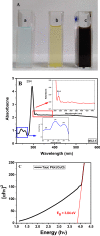Green synthesis of multifunctional carbon coated copper oxide nanosheets and their photocatalytic and antibacterial activities
- PMID: 34031470
- PMCID: PMC8196103
- DOI: 10.1038/s41598-021-90207-5
Green synthesis of multifunctional carbon coated copper oxide nanosheets and their photocatalytic and antibacterial activities
Erratum in
-
Author Correction: Green synthesis of multifunctional carbon coated copper oxide nanosheets and their photocatalytic and antibacterial activities.Sci Rep. 2021 Aug 13;11(1):16838. doi: 10.1038/s41598-021-96316-5. Sci Rep. 2021. PMID: 34389784 Free PMC article. No abstract available.
Abstract
The studies of metal oxides in environmental remediation of chemical and biological pollutants are gaining colossal importance. Herein, we report the facile synthesis of multifunctional copper oxide nanosheets (CuO NS) using an aqueous extract of Rhazya stricta. The phytochemical investigation of R. stricta indicated the presence of saponins, tannins, and reducing sugars, responsible for the reduction and stabilization of CuO NS. A UV-Visible spectrophotometer initially confirmed the fabrication of CuO NS with specific Surface Plasmon Resonance at 294 nm. Field Emission Scanning Electron Microscopy (FE-SEM), Fourier-transform infrared spectroscopy FTIR, and XRD were further used to characterize the CuO NS. The obtained CuO NS were poly-dispersed with an average size of 20 nm. Interestingly these particles were aligned together in 3D cubical sheets layered above each other via self-assembly. The as-synthesized CuO NS showed enhanced antibacterial potential (17.63 mm, overall mean inhibition zone) in comparison to the known antibiotics (11.51 mm, overall mean inhibition zone) against both Solanaceous crop's wilt-causing bacteria (Ralstonia solanacearum and Clavibacter michiganensis). Furthermore, the appreciable photocatalytic potential of CuO NS has also been observed, causing 83% degradation of methylene blue (MB) upon solar irradiation. The synthesis methodology is devoid of any toxic waste or by-products. It could be used to produce eco-friendly CuO nanomaterial for industrial uses.
Conflict of interest statement
The authors declare no competing interests.
Figures








Similar articles
-
Green synthesis of copper oxide nanoparticles using Ephedra Alata plant extract and a study of their antifungal, antibacterial activity and photocatalytic performance under sunlight.Heliyon. 2023 Feb 4;9(2):e13484. doi: 10.1016/j.heliyon.2023.e13484. eCollection 2023 Feb. Heliyon. 2023. PMID: 36816263 Free PMC article.
-
Green synthesis of copper oxide and manganese oxide nanoparticles from watermelon seed shell extract for enhanced photocatalytic reduction of methylene blue.Int J Phytoremediation. 2023;25(6):789-798. doi: 10.1080/15226514.2022.2109588. Epub 2022 Aug 17. Int J Phytoremediation. 2023. PMID: 35976777
-
Effect of the green synthesis of CuO plate-like nanoparticles on their photodegradation and antibacterial activities.Phys Chem Chem Phys. 2022 Dec 7;24(47):28923-28933. doi: 10.1039/d2cp03531f. Phys Chem Chem Phys. 2022. PMID: 36416292
-
Low-temperature phyto-synthesis of copper oxide nanosheets: Its catalytic effect and application for colorimetric sensing.Mater Sci Eng C Mater Biol Appl. 2019 Oct;103:109744. doi: 10.1016/j.msec.2019.109744. Epub 2019 May 15. Mater Sci Eng C Mater Biol Appl. 2019. PMID: 31349425
-
Eco-friendly synthesis of self-regenerative low-cost biosorbent by the incorporation of CuO: a photocatalyst sensitive to visible light irradiation for azo dye removal.Environ Sci Pollut Res Int. 2020 Sep;27(25):31074-31091. doi: 10.1007/s11356-020-09364-1. Epub 2020 Jun 10. Environ Sci Pollut Res Int. 2020. PMID: 32524399 Review.
Cited by
-
Bioengineering of CuO porous (nano)particles: role of surface amination in biological, antibacterial, and photocatalytic activity.Sci Rep. 2022 Sep 12;12(1):15351. doi: 10.1038/s41598-022-19553-2. Sci Rep. 2022. PMID: 36097028 Free PMC article.
-
Nano-crystallite bones of Oreochromis niloticus and Katsuwonus pelamis for the photocatalytic degradation of Congo red dye.Heliyon. 2023 Jul 5;9(7):e18012. doi: 10.1016/j.heliyon.2023.e18012. eCollection 2023 Jul. Heliyon. 2023. PMID: 37483710 Free PMC article.
-
The role of nanocomposites against biofilm infections in humans.Front Cell Infect Microbiol. 2023 Feb 28;13:1104615. doi: 10.3389/fcimb.2023.1104615. eCollection 2023. Front Cell Infect Microbiol. 2023. PMID: 36926513 Free PMC article. Review.
-
[Consensus document for severe asthma in adults. 2022 update].Open Respir Arch. 2022 Jul 2;4(3):100192. doi: 10.1016/j.opresp.2022.100192. eCollection 2022 Jul-Sep. Open Respir Arch. 2022. PMID: 37496585 Free PMC article. Spanish.
-
Chitosan-Grafted Polyacrylic Acid-Doped Copper Oxide Nanoflakes Used as a Potential Dye Degrader and Antibacterial Agent: In Silico Molecular Docking Analysis.ACS Omega. 2022 Nov 4;7(45):41614-41626. doi: 10.1021/acsomega.2c05625. eCollection 2022 Nov 15. ACS Omega. 2022. PMID: 36406528 Free PMC article.
References
-
- Corr SA. Metal oxide nanoparticles. Nanoscience. 2012;1:180–207. doi: 10.1039/9781849734844-00180. - DOI
-
- Mahapatra O, Bhagat M, Gopalakrishnan C, Arunachalam KD. Ultrafine dispersed CuO nanoparticles and their antibacterial activity. J. Exp. Nanosci. 2008;3:185–193. doi: 10.1080/17458080802395460. - DOI
-
- Noshad A, Hetherington C, Iqbal M. Impact of AgNPs on seed germination and seedling growth: A focus study on its antibacterial potential against Clavibacter michiganensis subsp. michiganensis infection in Solanum lycopersicum. J. Nanomater. 2019 doi: 10.1155/2019/6316094. - DOI
-
- Ramyadevi J, Jeyasubramanian K, Marikani A, Rajakumar G, Rahuman AA. Synthesis and antimicrobial activity of copper nanoparticles. Mater. Lett. 2012;71:114–116. doi: 10.1016/j.matlet.2011.12.055. - DOI
Publication types
LinkOut - more resources
Full Text Sources
Other Literature Sources
Miscellaneous

